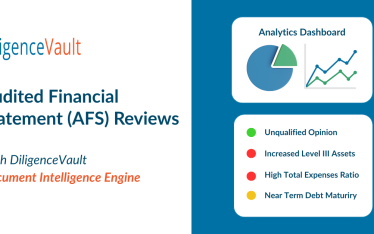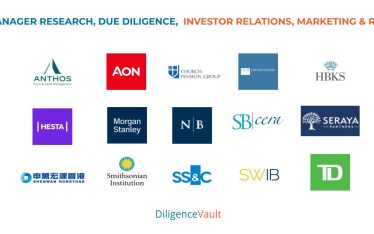Not that long ago, fund managers responding to RFPs and DDQs meant maintaining documents of questions and answers accumulated over time, having various people in the firm make comments and edit responses (sometimes even writing in the margins before there were digital collaboration capabilities!), printing out, putting it into a nice binder, and “FedEx’ing” the RFP to the asset owner. Things have changed. Thankfully, for the better.
With over 30,000 users on the DiligenceVault platform, including many of the world’s leading long-only, private equity and hedge funds, we’ve talked to numerous managers on how they organize, manage and communicate – both internally and externally – as part of the RFP and due diligence process. What we have found is that there are a number of similarities and differences in how managers, across size and regions, fulfill these critical tasks.
DiligenceVault is a digital due diligence platform, facilitating the information exchange between allocators and fund managers. Our goal is to solve the tedious, highly manual RFP and DDQ information exchange process for both asset owners and the manager community. As the evolution of the investment management industry continues, we continually strive to improve our platform to serve the needs of this community. As Vaulters, we are constantly gathering feedback from our clients and users. Here are some of our observations on how fund managers are optimizing their process, particularly in using the DiligenceVault platform.
Starting with the request and content
Let’s talk about the similarities first. As premium managers on our platform, most receive questionnaires in the form of Microsoft Excel or Word, which is then digitized on our platform. DV’s Word and Excel parser functionalities allow quick and easy extraction of questions in just a few clicks!
Pro tip: Spend time early to ensure you understand the various aspects of the investor request – what are the complexities – how big is it? How many questions? When is it due? What is the as of date? Is the request objective or subjective? What topics are covered in the request – does it involve a focus on ESG? Does it need extra approvals? Understanding these would help you best position who to collaborate with. Document these aspects on DiligenceVault and set up an appropriate review process.
Another functionality we’ve built is the Q&A bank, where responses are saved so you don’t have to re-type an answer every time an investor sends a questionnaire over. This allows for centralization of information so there will not be duplication of similar responses saved. This allows for a SME to review and approve answers before they are used in filling out RFPs and DDQs. Depending on how big your team is, we recommend a constant refresh of the answers stored every now and then and have dedicated SMEs (if any) to ensure responses are correct and up to date.
Pro tip: A timeline we have seen emerge as a best practice is that content refreshed on a quarterly basis, or as needed if there’s a significant shift in the firm and the product strategy.
For managers who work with clients in non-English speaking countries, language support becomes a big area of focus as often times the requests are not in English and things can get lost in translation. This is a trend, especially in EMEA and Asia.
Pro tip: Leave time for additional review if you also need translation review, or ask for an extension early on from the investor via the platform.
Turnaround and Collaboration
The use of a formal RFP or DDQs by asset owners has only been increasing over time, and can often come at the last minute with tight deadlines, making it difficult to pull together a thoughtful response in such a short period of time. For this reason, one needs to have at least 80 percent of the standard materials ready on the shelf to respond easily so that they can focus on the remaining 20 percent that needs to be customized for individual proposals. One piece of feedback we’ve gleaned from our conversations with fund managers is to take the time to understand the investor – who they are and what their perspectives are – so as to better understand the “why” in the questions they are asking. Indeed, the RFP and diligence questions they are asking can tell you many things about what they are thinking and how they are evaluating you.
Staff responsible for filling out RFPs and due diligence questionnaires need to seek feedback from portfolio managers to craft new responses for more complex questions – in which case product and functional experts, as well as portfolio managers, can act as SMEs and approve and update responses in the Q&A bank without the need for staff to chase up frequently.
The reality is portfolio managers are not RFP people, and are hyper-focused on their portfolios. This further emphasizes the importance of having a seamless and low-touch experience for them during an RFP. This can also help strengthen internal relationships between teams and promote collaboration.
Pro-tip: Ensure all your stakeholders have an account on DiligenceVault, to avoid last-minute friction points
DEI and ESG
As ESG and DEI diligence becomes more commonplace across all types of asset classes and strategies, fund managers are seeing a significant uptick in ESG-focused questions making their way onto RFPs and DDQs. In fact, many managers are seeing ESG and DEI-specific questionnaires coming to them. Often, the ESG questions they are receiving become the drivers in shaping their own internal ESG policies. Managers that try to “greenwash” their ESG efforts will surely be exposed by asset allocators and asset owners.
Fund managers are also now developing programs and recruitment strategies to improve diversity, with an emphasis on purposeful hiring, unconscious bias training, and reviewing business relationships from a values point of view. According to Alliance Global Advisors, DEI should be integrated across all day-to-day activities. Accounting and reporting on DEI initiatives may fall within general firm practices or ESG, and typically requires the oversight of Human Resources. Best practices encourage the involvement and ultimate endorsement of Executive Leadership.
Pro-tip: Anytime you see new questions coming in across a new theme, ensure you develop a framework to collate all new questions and add it to your pre-approved library for future use
A better way
With the increasing complexity of RFPs and the spotlight shining on DEI and ESG, using technology to reduce the pain in conducting due diligence should be “the new normal” – a phrase we are now all familiar with. A digital due diligence platform is the only solution that allows for facilitating information exchange with not just clients, but also managing workflow within the asset management firm. Reduce inefficiencies and error-prone manual tasks with digital diligences? Check. DDQ responses at the click of a button? You have it. Internal collaboration? Consider it done.
If it’s done manually the whole process generally takes anywhere from a month to three months and sometimes a lot longer depending on the project size and complexities. When the process is automated, however, the response time can be cut down easily by 40% to 50% on an average.
Best practices using DiligenceVault
Managers that are premium subscribers to the DV platform can utilize Q&A bank functionality to organise centralized information, but, more than that, it is about having accountability within the team, internal collaboration, and removing repetition of tasks that you would otherwise have to go through the pain of. The top 3 functionalities in our platform that will ease your pain during the due diligence process include, but not limited to:
- Assign to team members: You can now do away with messaging your co-worker privately to make sure they are on their task. In the questionnaire itself, you can assign an entire section or individual questions to a coworker, in which our system notifies them of their assignment(s). As they complete the task, you have real-time transparency. Seamless collaboration between RFP teams, business development and compliance is key.
- Pre-approved questions: Populate a questionnaire with responses to make sure these are saved within the Q&A bank for a SME’s approval. These responses can be used in DDQs so you no longer need to type the same response over and over again for various DDQs coming your way, eliminating errors and using stale responses.
- Educate your team with review workflow: Junior analysts can assign reviewers for their work through our review workflow functionality. Reviewers can approve, reject, or send it back to the author for amendments, providing the necessary feedback for the team members to learn.
Shifts in asset allocation and investments in new strategies and asset classes is increasing the complexity and volume of RFPs and DDQs issued by asset owners. Managers on the receiving end of an RFP shouldn’t dread having to fill them out. In fact, it should be a cause for celebration! It’s an opportunity to expand your client base, AUM and showcase your firms’ and strategy strengths. How a manager organizes their content, collaborates on answers and ultimately leverages the technology available to them in communicating with the asset owner can be the difference in what has historically been a confounding experience into a smooth-running machine.



